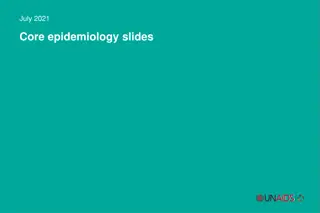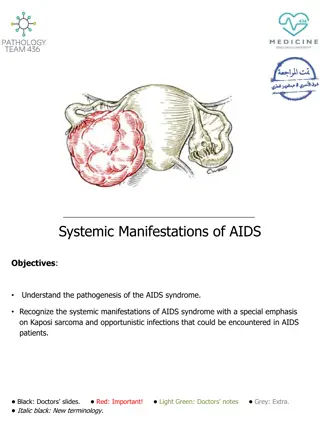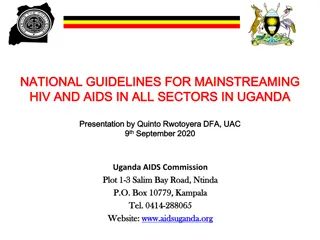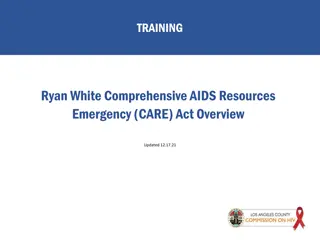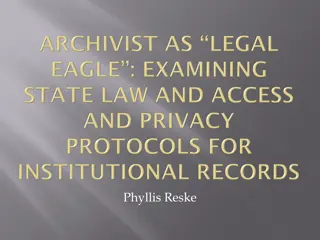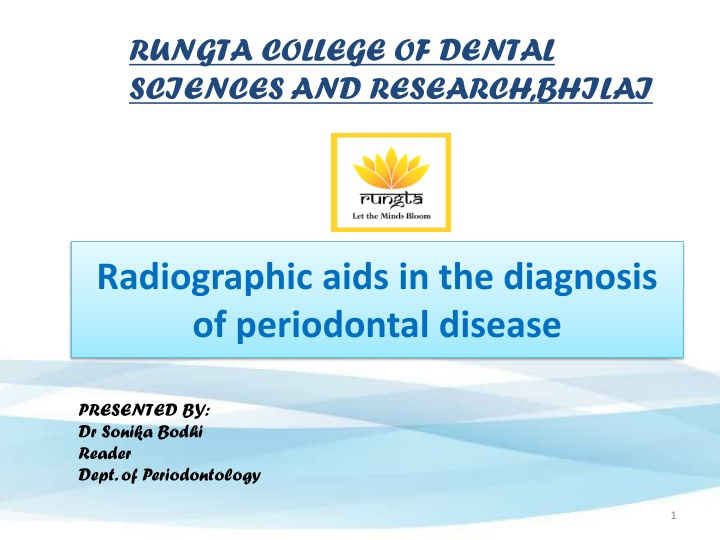
Radiographic Aids in Diagnosis of Periodontal Disease
Learn about the importance of radiographic aids in diagnosing periodontal disease, evaluating prognosis and treatment outcomes. Discover how radiographs reveal past cellular activity on bone and roots, and understand the significance of normal interdental septa in assessing bone changes. Explore the appearance of Lamina dura and its role in indicating bone surface lining and tooth socket health.
Download Presentation

Please find below an Image/Link to download the presentation.
The content on the website is provided AS IS for your information and personal use only. It may not be sold, licensed, or shared on other websites without obtaining consent from the author. If you encounter any issues during the download, it is possible that the publisher has removed the file from their server.
You are allowed to download the files provided on this website for personal or commercial use, subject to the condition that they are used lawfully. All files are the property of their respective owners.
The content on the website is provided AS IS for your information and personal use only. It may not be sold, licensed, or shared on other websites without obtaining consent from the author.
E N D
Presentation Transcript
RUNGTA COLLEGE OF DENTAL SCIENCES AND RESEARCH,BHILAI Radiographic aids in the diagnosis of periodontal disease PRESENTED BY: Dr Sonika Bodhi Reader Dept. of Periodontology 1
SPECIFIC LEARNING OBJECTIVES CORE AREAS Introduction Normal interdental septa Radiographic techniques DOMAIN Affective Cognitive Pshycomotor CATEGORY Desire to know Must to know Must to know Patterns of bone loss in periodontal diseases Radiographic appearances of periodontal diseases Cognitive Must to know Pshycomotor Must to know Digital intraoral radiography Pshycomotor Nice to know 2
CONTENTS Introduction Normal interdental septa Radiographic techniques Patterns of bone loss in periodontal diseases Radiographic appearances of periodontal diseases Digital intraoral radiography Summary 3
Introduction The radiograph is a valuable aid in the diagnosis of periodontal disease, determination of the prognosis, and evaluation of the outcome of treatment. However, the radiograph is an adjunct to the clinical examination, not a substitute for it. 4
The radiograph reveals alteration in calcified tissues. It does not reveals current cellular activity but shows effects of past cellular experience on the bone & roots. 5
NORMAL INTERDENTAL SEPTA Radiographic evaluation of bone changes in periodontal diseases is based mainly on appearance of interdental septa , because the relatively dense root structure obscures the facial and lingual bony plates. The interdental septum normally presents a thin radiopaque border that is adjacent to the PDL and at alveolar crest, termed as Lamina dura. 6
Lamina dura appears radiographically as a continuous white line, but in reality it is perforated by Numerous small foramina, Traversed by blood vessels, lymphatics & nerves, which pass between the PDL & bone. Because the lamina dura represents the bone surface lining the tooth socket, the shape and position of the root & changes in the angulation of the X-ray beam produce considerable variations in its appearance. 8
The width and shape of the interdental bone and the angle of the crest normally vary according to the convexity of the proximal tooth surfaces and the level of the cementoenamel junction (CEJ) of the approximating teeth. The angulation of crest of interdental septum is generally parallel to line between the CEJs of approximating teeth. When there is a difference in the level of the CEJs, the crest of the interdental bone appears angulated rather than horizontal. 9
RADIOGRAPHIC TECHNIQUES In conventional radiographs, periapical and bite-wing projections offer the most diagnostic information and are most commonly used in the evaluation of periodontal disease. Standardized, reproducible techniques are required to obtain reliable radiographs for pre-treatment and post-treatment comparisons. 11
Prichard established the following four criteria to determine adequate angulation of periapical radiographs: 1. The radiograph should show the tips of molar cusps with little or none of the occlusal surface showing. 2. Enamel caps and pulp chambers should be distinct. 3. Interproximal spaces should be open. 4. Proximal contacts should not overlap unless teeth are out of line anatomically. 12
BONE DESTRUCTION IN PERIODONTAL DISEASE The radiograph does not reveal minor destructive changes in bone. Therefore, slight radiographic changes in the periodontal tissues mean that the disease has progressed beyond its earliest stages. The earliest signs of periodontal disease must be detected clinically. 13
BONE LOSS The radiographic image tends to underestimate the severity of bone loss. The difference between the alveolar crest height and the radiographic appearance ranges from 0 to 1.6 mm, mostly accounted for by x-ray angulation. 14
Radiographs are an indirect method for determining the amount of bone loss in periodontal disease; they image the amount of remaining bone rather than the amount lost. The amount of bone lost is estimated to be the difference between the physiologic bone level and the height of the remaining bone. A distance of 2 mm between CEJ and alveolar crest reflects normal periodontium; this distance may be greater in older patients. 15
PATTERN OF BONE DESTRUCTION In periodontal disease the interdental bone undergoes changes that affect the lamina dura, crestal radiodensity, size and shape of the medullary spaces, and height and contour of the bone. Height of interdental bone may be reduced, with the crest perpendicular to the long axis of the adjacent teeth (horizontal bone loss) or angular or arcuate defects (angular, or vertical, bone loss) could form. 16
Radiographs do not indicate the internal morphology or depth of craterlike defects. the extent of involvement on the facial and lingual surfaces. 17
In most cases, it can be assumed that bone losses seen interdentally continue in either the facial or the lingual aspect, creating a troughlike lesion. A reduction of only 0.5 to 1.0 mm in the thickness of the cortical plate is sufficient to permit radiographic visualization of the destruction of the inner cancellous trabeculae. 18
Radiographic Appearance of Periodontal Disease Periodontitis Interdental craters Furcation involvement Periodontal abscess LAP TFO 19
Fuzziness break continuity of the lamina dura at the crest of the bone distal to the central incisor (left). There are wedge-shaped radiolucent areas at the crests of the other interdental septa. and in a PERIODONTITIS Normal appearance of interdental septa. the Radiolucent projections from the crest into the interdental septum indicate extension of destructive processes. Severe bone loss. 20
INTERDENTAL CRATERS Interdental craters are seen as irregular areas of reduced radiopacity on the alveolar bone crests. Craters are generally not sharply demarcated from the rest of the bone, with which they blend gradually. Radiographs do not accurately depict the morphology or depth of interdental craters, which sometimes appear as vertical defects. 21
FURCATION INVOLVEMENT Definitive diagnosis of furcation involvement is made by clinical examination, which includes careful probing with a specially designed probe (e.g., Nabers). Radiographs are helpful but show artifacts that allow furcation involvement to be present without detectable radiographic changes. 22
As a general rule, bone loss is always greater than it appears in the radiograph. Variations in the radiographic technique may obscure the presence and extent of furcation involvement. A tooth may present marked bifurcation involvement in one film but appear to be uninvolved in another. 23
The slightest radiographic change in the furcation area should clinically, especially if there is bone loss on adjacent roots . be investigated 25
Diminished radiodensity in the furcation area in which outlines of bony trabeculae are visible suggests furcation involvement 26
Whenever there is marked bone loss in relation to a single molar root, it may be assumed that the furcation is also involved 27
PERIODONTAL ABSCESS In the early stages the acute periodontal abscess is extremely painful but presents no radiographic changes. The extent of bone destruction and the morphologic changes of the bone. The location of the abscess. Lesions in the soft tissue wall of a periodontal pocket are less likely to produce radiographic changes than those deep in the supporting tissues. Abscesses on the facial or lingual surface are obscured by the radiopacity of the root; interproximal lesions are more likely to be visualized radiographically. Therefore the radiograph alone cannot be relied on for the diagnosis of a periodontal abscess. 28
Localized Aggressive Periodontitis Bone loss may occur initially in the maxillary and mandibular incisor and/or first molar areas, usually bilaterally, and results in vertical, arc like destructive patterns. Loss of alveolar bone may become generalized as the disease progresses but remains less pronounced in the premolar areas. 29
TRAUMA FROM OCCLUSION Trauma from occlusion can produce radiographically detectable changes in the lamina dura, morphology of the alveolar crest, width of the PDL space, and density of the surrounding cancellous bone. 30
The injury phase of trauma from occlusion produces a loss of the lamina dura that may be noted in apices, furcations, and marginal areas. This loss of lamina dura results in widening of the PDL space. The repair phase of trauma from occlusion results in an attempt to strengthen the periodontal structures to better support the increased loads. Radiographically, this is manifested by a widening of the PDL space, which may be generalized or localized. 31
More advanced traumatic lesions may result in deep angular bone loss, which, when combined with marginal inflammation, may lead to intrabony pocket formation. In terminal stages these lesions extend around the root apex, producing a wide, radiolucent periapical image (cavernous lesions). 32
DIGITAL INTRAORAL RADIOGRAPHY Digital imaging in addition to the image manipulation features, digital radiographic images facilitate patient education, allow for easy storage, and sharing with other healthcare providers, and can be easily integrated into electronic patient records. 33
Digital intraoral radiographic systems use either solid-state detectors or photostimulable phosphor (PSP) plates. Systems with solid-state detectors use either charge-coupled devices (CCDs) or complementary metal oxide semiconductor (CMOS) chips as image receptors. 34
These receptors are typically wired and connected to a computer using a Universal Serial Bus (USB) connection. Wireless sensors are also available and require the use of disposable batteries. With CCD/CMOS-based receptors, images are recorded and displayed on a computer monitor virtually in real time. 35
Summary Conventional radiographs are helpful to evaluate the height and form of interdental bone, width of PDL, continuity of lamina dura, trabecular pattern of bone, root resorption, caries and periapical pathology, etc. However they may not depict bony changes in the facial and lingual surfaces such as fenestration and dehiscences, early stages of furcation involvement, osseous defects like craters. Moreover they do not inform about current disease activity. Advanced imaging techniques such as digital radiography and CBCT provide more accurate details. 36
References Newman MG, Takei HH, Klokkevold PR, Carranza FA. Carranza s clinical periodontology, 10th ed. Saunders Elsevier; 2007. Lindhe J, Lang NP and Karring T. Clinical Periodontology and Implant Dentistry. 6th ed. Oxford (UK): Blackwell Publishing Ltd.; 2015. Newman MG, Takei HH, Klokkevold PR, Carranza FA. Carranza s clinical periodontology, 13th ed. Saunders Elsevier; 2018. 37






